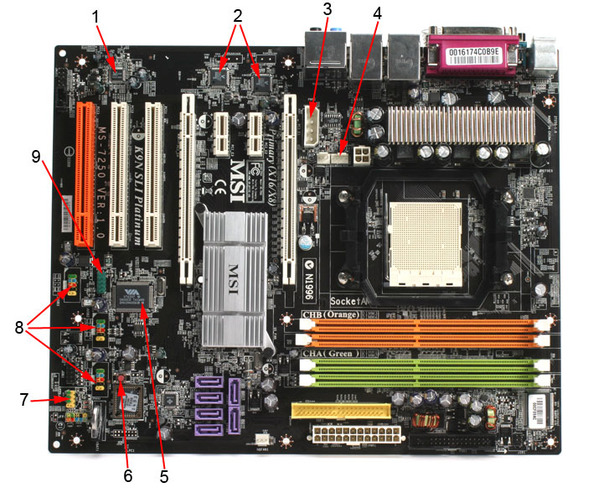

The first problem that we came across when installing the board was the positioning of the IDE port. We feel that this could have been swapped with the floppy port, that way you don't need to go behind the ATX socket in order to plug in your cable and route it around. Typically an ATX cable will go upward and the IDE will go out right of the board, so you end up having to wrap one around the other in a less-than-ideal way.
Secondly, both the memory slots and voltage regulator heatsinks are quite close to either side of the CPU, although these are low profile unlike the ones on the ASUS M2N32-SLI Deluxe. Plugging in the CPU fan, the ATX 12V plug and additional molex power connector proved to be rather tight when installing a large heatsink like the Zalman CNPS9500. We also tried AMD's stock cooling fan too, and while it was not as tight, installation was still less than optimal.
Finally the heatsink used for the nForce 570 SLI MCP isn't heat-piped to draw the heat away from the middle of the board out to the edge. Instead, the heatsink just emits heat upwards into the video card heatsink. When using a high end video card from either ATI or NVIDIA, there is going to be very little air passing over the nForce 570 SLI's heatsink. This is because the video card heatsinks are shrouded to direct air across the length of the cards, leaving a rather warm dead spot right where the MCP heatsink is.
Despite these grievances there are also several positive aspects to the K9N SLI Platinum's layout. The first outstanding feature of the board is the inclusion of two PCI-Express x1 slots and three PCI slots. Should you be looking to install either one or two single slot video cards, you will be able to use to use all three PCI slots and both PCI-Express x1 slots too - this is incredibly useful if you're one to use lots of add-in cards.
The SATA 3Gbps ports are all placed so you can still use them even if two full length video cards are installed. The front panel pins are colour coded making for an easier installation; the same is true for the USB 2.0 pin headers too, which helps identify them. A note for the overclockers: you'll be happy to know that MSI has included a push button for the CMOS reset switch, rather than a fiddly jumper to flick.
MSI also has an interesting way of colour coding the memory slots; unlike virtually every other where motherboard manufacturer, dual channel memory is installed in pairs adjacent to each other, the memory slots are grouped by channel which means you need to install two memory modules in alternate-coloured slots to enable dual channel.

MSI MPG Velox 100R Chassis Review
October 14 2021 | 15:04






Want to comment? Please log in.